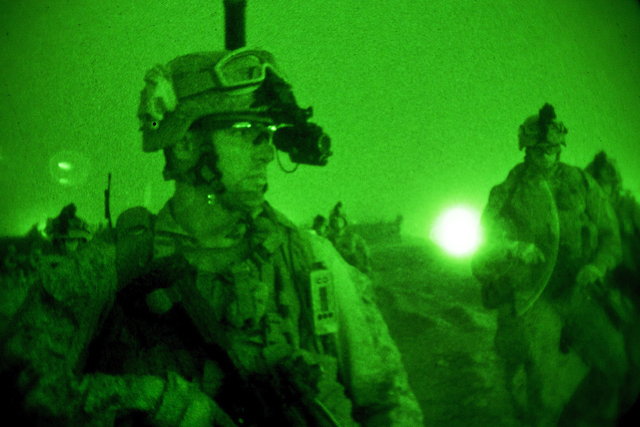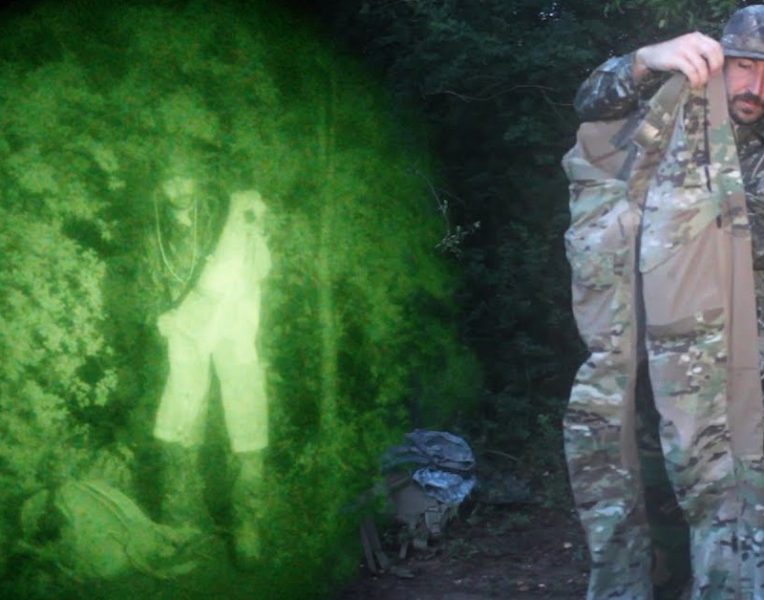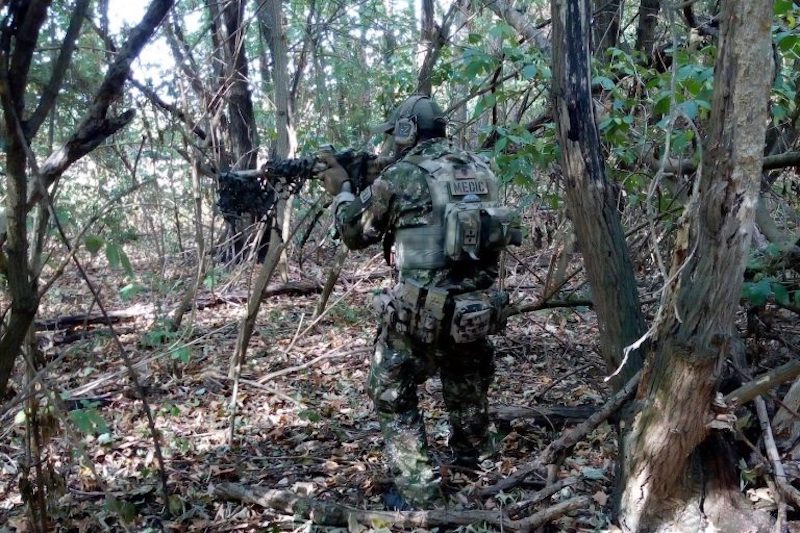Get the weekly SPARTANAT newsletter.
Your bonus: the free E-Book from SPARTANAT.

BASICS: Infrared camouflage in tactical equipment
ZENTAURON specializes in producing equipment with infrared camouflage to blend in with night vision devices. They use advanced methods like printing, coating, and weaving to achieve effective near-range infrared camouflage.
Equipment manufacturers know: what you see with the naked eye is not the only important thing. At ZENTAURON, for example, everyone understands that camouflage patterns like Flecktarn and others are good for blending in. But the battle is also fought in a different spectrum, in the infrared range used by night vision devices.
What is hardly visible with camouflage patterns in nature becomes a white area in the landscape in the infrared range of night vision devices at night. ZENTAURON only produces equipment that is safe in the NIR range – explained below. Camouflaged ZENTAURON equipment in Flecktarn, Tropentarn, Olive, Coyote colors is manufactured according to Bundeswehr TL specifications, both in Cordura, plastic parts, and webbing. Multicam and A-TACS meet MilSpec and CONCAMO standards in accordance with BW TL.
From ZENTAURON, there is also this exciting introduction to the topic of equipment and IR security. We are pleased to present it to you today in collaboration with ZENTAURON.
Infrared camouflage of textiles
Every modern tactical equipment and military clothing for soldiers is equipped with an IR camouflage today. Night missions are standard as well as working with night vision devices in the military. We want to shed some light on how IR camouflage is actually achieved.
Particularly in the NIR (Nearfield Infrared), adjusting the brightness level and structuring it to match the average brightness and structure of the background is essential to avoid detection through night vision devices.
This means that in addition to the visible camouflage – the actual camouflage print – an invisible layer in the NIR spectrum is added.
For fabrics, webbing, as well as zippers and plastic buckles that are not treated, so much of the infrared radiation is reflected back that they appear very bright – almost white – in night vision devices.
To prevent this and not have the soldier and his equipment appear as a white ghost in his nighttime environment, an elaborate camouflage system is needed.

Bad example: Parts of the pants are not IR-safe. In night vision, they appear completely white. Also, notice how the shading of the IR-safe camouflage blends into the foliage.
How does the textile get its IR camouflage in the near range?
Methods for military clothing and equipment
There are essentially only a few methods that can achieve this effect. This is achieved by adding carbon black pigments or by coating with these pigments.
Printing:
When printing military textiles, the individual printing colors are adjusted by adding carbon particles so that the prescribed reflection values by the military are met. This creates a camouflage print that reliably fulfills its function in both (IRR and visible) spectrums.
This method has proven itself and has good camouflage effects with good rub fastness and wash permanence.
Coating:
In coating, which is mostly used on solid-colored fabrics and webbing, pigments are normally applied and fixed to the textile fibers with a binder system, which can result in poor rub fastness values of the colors and lack of wash permanence.
Weaving:
In this method, individual pre-treated fibers are processed into a yarn by weaving into a fabric or webbing, which is then used in infrared textiles. It is possible to create a pattern visible only in the near infrared range (NIR) with varying amounts of coated individual fibers and appear monochrome in the visible spectrum.
The issue here is that only the patterning as such, but not individual colors or areas with different reflection values, can be equipped. This method is also one of the most expensive and is more commonly used in webbing. However, the rub fastness values and wash permanence in this method are exceptionally good.

Bad example: ZENTAURON ZFR medic backpack compared to an official medic backpack of the Bundeswehr. The latter does not have any NIR camouflage.
Adding to military buckles and zippers
The carbon black pigments are added to the base material. This method is mainly used for plastic products. In particular, all buckles, zippers, as well as weapons and attachments are worth mentioning. This method is permanent and does not deteriorate with use.
Use and application:
The camouflage in the NIR range should not be underestimated, as it allows the soldier to not be the proverbial highlight in the forest. Modern armies pay close attention to the remission behavior of the uniforms and equipment used. Camouflage in the NIR range can determine the success or failure of the mission and the life of the individual soldier. Night vision devices are increasingly common and continuously improving. (In Afghanistan alone, the Taliban "captured" 16,000 night vision devices, making them "night combat-capable.")
If individual equipment items do not have this camouflage, the entire squad of shooters and thus the mission is in danger. Inadequate camouflage makes reconnaissance at night much easier for the enemy. Therefore, supervisors should also pay attention to this, and if in doubt, take a look at the shooter squad with night vision devices before departure to ensure that the camouflage also meets the requirements at night.

Terrain forms and their characteristics:
Different terrain forms require coordinated camouflage. What works well in the forest is counterproductive in snowy conditions, and also not the best choice in built-up areas.
The reflectance values must be adjusted to the terrain in which one moves. Mixing different camouflage prints on individual uniforms and equipment items can be helpful in blurring the silhouette of the soldier and providing security through camouflage for him and the shooter squad.
Especially when moving into other terrain forms, it is advisable to continuously evaluate oneself and one's equipment within the shooter squad, and to remedy any deficiencies in camouflage as quickly as possible.
How to maintain and care for IRR-optimized fabric
All IRR textiles are susceptible to wear from rubbing, but also to cleaning and adherence or dirt, which can compromise their camouflage properties in whole or in part. Special attention should be paid to cleaning the uniform and equipment here.
Washing the uniform with normal detergents containing bleaches or brighteners is particularly harmful, as this can undo the IRR coating settings.
The use of fabric softeners is also not advisable, as particles introduced into the fabric can affect the camouflage effect.
Cleaning equipment such as backpacks and protective vests as well as attached pockets should be done as gently as possible. Warm water and hand washing are the preferred methods here.
In case of stubborn dirt, neutral soap or another detergent without additives of brighteners and bleach can also be used.
Knowledge of the basics ensures: The materials used by ZENTAURON - such as Cordura fabric, which is used in almost all pockets, plate carriers, protective vests, and backpacks - meet all requirements and not only provide the necessary camouflage in daylight, but also under night vision conditions. Because: Camouflage means protection.
ZENTAURON on the Internet
We have introduced the new SPARTANAT BASICS category for you. With this, we present you the basics that you always wanted to know how they work.
SPARTANAT is the online magazine for Military News, Tactical Life, Gear & Reviews.
Send us your news: [email protected]
Ad
similar
Get the weekly SPARTANAT newsletter.
Your bonus: the free E-Book from SPARTANAT.


